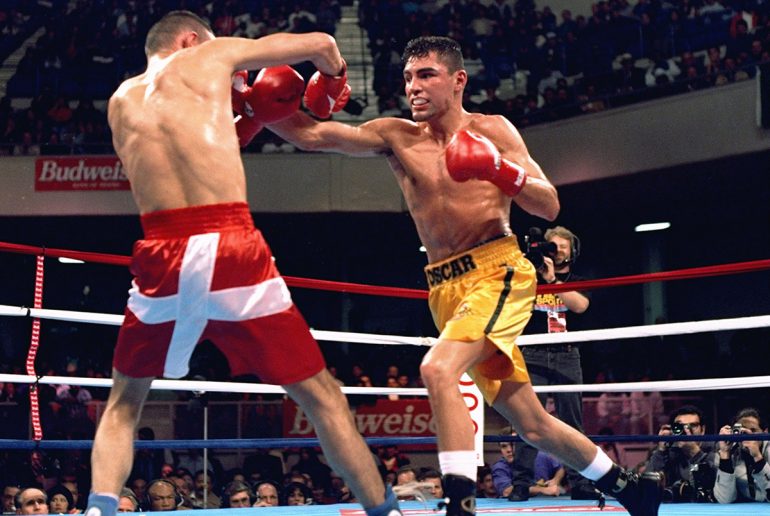On this day: Oscar de la Hoya stops Jimmi Bredahl to lift his first world title belt

Graduation night comes early for boxing’s most-likely-to-succeed, and Oscar de la Hoya was no exception to that rule.
Less than two years into his professional career after earning a gold medal in the Barcelona 1992 Olympics, the 21-year-old De la Hoya was already clamoring for a world title opportunity, backed by his crossover appeal and huge popularity. With less than a dozen pro fights under his belt and the self-imposed mission of one day becoming a record-breaking multi-weight champion, De la Hoya and his handlers (Bob Arum’s Top Rank on the managerial side, HBO on the broadcasting side) were growing impatient as most of the junior lightweight titlists available priced themselves out of a fight just at the time when the young Oscar was already outgrowing the division.
When then-reigning WBA king Genaro “Chicanito” Hernandez made it clear that his price range was simply too high at that stage of his career, Top Rank and HBO looked elsewhere for alternative solutions. The cable giant did not recognize the WBO as a major sanctioning body at that time, oftentimes not even mentioning their titles even in their own broadcasts. But as it became apparent that the champions of the day were simply trying to get retirement-fund money out of the young East LA product, they changed their views.
Enter Denmark’s Jimmi Bredahl, an unbeaten southpaw with a glossy 16-0 record and only five stoppages to his credit, holding the WBO belt he had grabbed from Daniel Londas at around the time when Oscar was returning home from the Olympics.
The stage was set for De la Hoya’s homecoming coronation, which was scheduled as part of the reopening of Los Angeles’ Olympic Auditorium for boxing after a decade away from the sport and a $5 million-dollar renovation.
Even after punishing his body at his Big Bear Lake training camp to make weight comfortably, De la Hoya knew that energy would be a factor in the fight, and he stormed out of the gates to drop Bredahl in the first round in his search for an early stoppage. Bredahl got up bravely but was no match for De la Hoya’s will to become champion in front of his people, visiting the canvas again in the second round. The Danish titlist endured a steady beating until he failed to answer the bell for the eleventh round.
Against all odds, De la Hoya remained in the division for one defense of his belt, which was then recognized by HBO (and soon after, by most boxing media outlets and other networks) as a more legitimate title, thus giving birth to the current “four-belt era” along with the more established WBA, WBC and IBF belts (in order of appearance). De la Hoya jumped to the lightweight division soon after that, getting a belt from Jorge Paez and later defeating Genaro Hernandez in a memorable clash that further validated De la Hoya’s claim as the best fighter in the world in the 130-135 pound region.
Eleven belts in six weight classes would follow after that, but March 5, 1994 marked the beginning of Oscar’s path to greatness – and the beginning of a new era in championship boxing.
Diego M. Morilla has written for The Ring since 2013. He has also written for HBO.com, ESPN.com and many other magazines, websites, newspapers and outlets since 1993. He is a full member of the Boxing Writers Association of America and an elector for the International Boxing Hall of Fame. He has won two first-place awards in the BWAA’s annual writing contest, and he is the moderator of The Ring’s Women’s Ratings Panel. He served as copy editor for the second era of The Ring en Español (2018-2020) and is currently a writer and editor for RingTV.com.















